|
||||||||||||||||||||||
![Home - Air Power Australia Website [Click for more ...]](APA/APA-Title-NOTAM.png) |
||||||||||||||||||||||
![Sukhoi PAK-FA and Flanker Index Page [Click for more ...]](APA/flanker.png) |
![F-35 Joint Strike Fighter Index Page [Click for more ...]](APA/jsf.png) |
![Weapons Technology Index Page [Click for more ...]](APA/weps.png) |
![News and Media Related Material Index Page [Click for more ...]](APA/media.png) |
|||||||||||||||||||
![Surface to Air Missile Systems / Integrated Air Defence Systems Index Page [Click for more ...]](APA/sams-iads.png) |
![Ballistic Missiles and Missile Defence Page [Click for more ...]](APA/msls-bmd.png) |
![Air Power and National Military Strategy Index Page [Click for more ...]](APA/strategy.png) |
![Military Aviation Historical Topics Index Page [Click for more ...]](APA/history.png)
|
![Intelligence, Surveillance and Reconnaissance and Network Centric Warfare Index Page [Click for more ...]](APA/isr-ncw.png) |
![Information Warfare / Operations and Electronic Warfare Index Page [Click for more ...]](APA/iw.png) |
![Systems and Basic Technology Index Page [Click for more ...]](APA/technology.png) |
![Related Links Index Page [Click for more ...]](APA/links.png) |
|||||||||||||||
![Homepage of Australia's First Online Journal Covering Air Power Issues (ISSN 1832-2433) [Click for more ...]](APA/apa-analyses.png) |
|
|||||||||||||||||||||
| Last Updated: Mon Jan 27 11:18:09 UTC 2014 | ||||||||||||||||||||||
|
||||||||||||||||||||||
|
||||||||||||||||||||||
![Home - Air Power Australia Website [Click for more ...]](APA/APA-Title-NOTAM.png) |
||||||||||||||||||||||
![Sukhoi PAK-FA and Flanker Index Page [Click for more ...]](APA/flanker.png) |
![F-35 Joint Strike Fighter Index Page [Click for more ...]](APA/jsf.png) |
![Weapons Technology Index Page [Click for more ...]](APA/weps.png) |
![News and Media Related Material Index Page [Click for more ...]](APA/media.png) |
|||||||||||||||||||
![Surface to Air Missile Systems / Integrated Air Defence Systems Index Page [Click for more ...]](APA/sams-iads.png) |
![Ballistic Missiles and Missile Defence Page [Click for more ...]](APA/msls-bmd.png) |
![Air Power and National Military Strategy Index Page [Click for more ...]](APA/strategy.png) |
![Military Aviation Historical Topics Index Page [Click for more ...]](APA/history.png)
|
![Intelligence, Surveillance and Reconnaissance and Network Centric Warfare Index Page [Click for more ...]](APA/isr-ncw.png) |
![Information Warfare / Operations and Electronic Warfare Index Page [Click for more ...]](APA/iw.png) |
![Systems and Basic Technology Index Page [Click for more ...]](APA/technology.png) |
![Related Links Index Page [Click for more ...]](APA/links.png) |
|||||||||||||||
![Homepage of Australia's First Online Journal Covering Air Power Issues (ISSN 1832-2433) [Click for more ...]](APA/apa-analyses.png) |
|
|||||||||||||||||||||
| Last Updated: Mon Jan 27 11:18:09 UTC 2014 | ||||||||||||||||||||||
|
||||||||||||||||||||||
Hybridisation of Surface to Air
Missile Systems
|
||||||||||||||||||||||||||||
|
Air Power
Australia - Australia's Independent Defence Think Tank
|
||||||||||||||||||||||||||||
| Air Power Australia NOTAM 18th January, 2009 Updated May, 2012 |
||||||||||||||||||||||||||||
|
||||||||||||||||||||||||||||
|
||||||||||||||||||||||||||||
 The new Belarus KB Radar Vostok E
is a high mobility LPI capable VHF-band solid state counterstealth
radar which is marketed globally as a replacement for P-18 Spoon Rest
radars in legacy Soviet SAM system batteries. It is an excellent case
study of hybridisation of legacy threat SAM systems with entirely new
battery components (KB Radar image).
|
||||||||||||||||||||||||||||
|
A problem which has received
little attention in the West over recent years is the ongoing evolution
of Cold War era legacy Surface to Air Missile systems. We are not only
observing some sophisticated upgrades being applied, but evidence is
now emerging that hybridisation may be occuring on a larger scale than
previously appreciated.
In terms of direct upgrades to legacy systems, the most prominent have been the various packages developed for the semi-mobile S-125 Pechora/Neva / SA-3 Goa and its SNR-125 Low Blow engagement radar. Upgrades are also available for the S-200 Angara/Vega/Dubna / SA-5 Gammon and its 5N62 Square Pair engagement radar, as well as the 2K12 Kub/Kvadrat / SA-6 Gainful, and the 9K33 Romb/Osa / SA-8 Gecko. These upgrades parallel a very similar trend observed in widely deployed legacy Soviet era early warning, search and acquisition radars. Upgrade packages are on offer for the P-14 Tall King, P-15 Flat Face, P-18 Spoon Rest, and P-35/37 Big Bar / Big Mesh / Bar Lock series. The motives for existing users of such equipment are simple: retaining and extending the service life of often large inventories of equipment, and large warstocks of missile rounds. In addition, the more sophisticated upgrades increase the capability of these systems, with many examples increasing radar performance, jam resistance and track capabilities, and some examples improving either mobility of the system, or the kinematic range of the missiles. It is worth considering that many thousands of such systems and radars were built and exported by the Soviets before the end of the Cold War, with recipients ranging from former Soviet republics, former Warsaw Pact nations, former Soviet allies, and Third World nations being courted or influenced by the Soviets. In parallel, China has developed and maintained its own market for indigenous and cloned Soviet missiles and radars. Players in the upgrade market vary from the OEMs who either designed or manufactured portions of these systems, or whole systems, as well as organisations performing depot level overhauls. There has been no shortage of such players, nor has there been any shortage of proposed, prototyped or sold upgrades. Prominent in this market are OEMs based in ByeloRussia and the Ukraine, both former Soviet republics with large military industrial infrastructure which previously manufactured or overhauled many of these systems. Given the absence of an established nomenclature for upgrades of legacy Cold War era systems, APA will define one for convenience: Class 1 Upgrades will involve the replacement of Soviet era electronic, electrical, electro-explosive and mechanical components which are obsoleted and no longer supportable, with current production equivalents. Such upgrades retain the capabilities and limitations of the original design, but extend its service life over the effective service life of the new components. Class 2 Upgrades will involve the replacement of Soviet era electronic, electrical, electro-explosive and mechanical components which are obsoleted and no longer supportable, with current production equivalents, plus the replacement of key functional components such as radar receivers, transmitters, signal processors and data processors with modern digital equivalents. Such upgrades expand the capabilities and performance of the system, and more than often impact key EW parameters such as jam resistance, and radar detection range. As the original antennas and scan formats are retained, the design may still retain many of the electronic vulnerabilities of the original. Class 3 Upgrades are mobility enhancements of Class 1 or 2 upgrades, where the launchers and often engagement radars are rehosted on new trailers, or rebuilt as fully self propelled units on new built chassis. Such upgrades alter the fundamental regime of deployment and vastly enhance survivability, especially where the mobility upgrade replaces cables with digital radio datalinks, and digital automation shortens deployment and stow times for the system, or the missile battery as a whole. Class 4 Upgrades involved hybridisation, where an entirely new engagement radar, and often new acquisition radar, is introduced to fully supplant the legacy Soviet era radars characteristic of the weapon system. A Class 4 upgrade may be performed in parallel with a Class 1, 2 or 3 upgrade on the remaining system components. Table 1 shows some examples of legacy systems and available upgrades: |
||||||||||||||||||||||||||||
|
||||||||||||||||||||||||||||
 The large 160 nautical mile range S-200 /
SA-5 Gammon SAM system has been widely exported, with users including
North Korea, Syria and most recently, Iran. The semimobile 5P72
launchers each carry a single 5V21 or 5V28 FMCW SARH missile round.
 K-1M
cabin
with 5N62 Square
Pair FMCW illuminator (above), 5N63S/30N6E phased array engagement
radar (below). The hybridisation of the SA-5/SA-20 is the best known
recent instance of this upgrade strategy. While details have not been
disclosed by Almaz-Antey, the technologies involved provide a good
indication of the capabilities of this upgrade (Image © Miroslav
Gyűrösi).
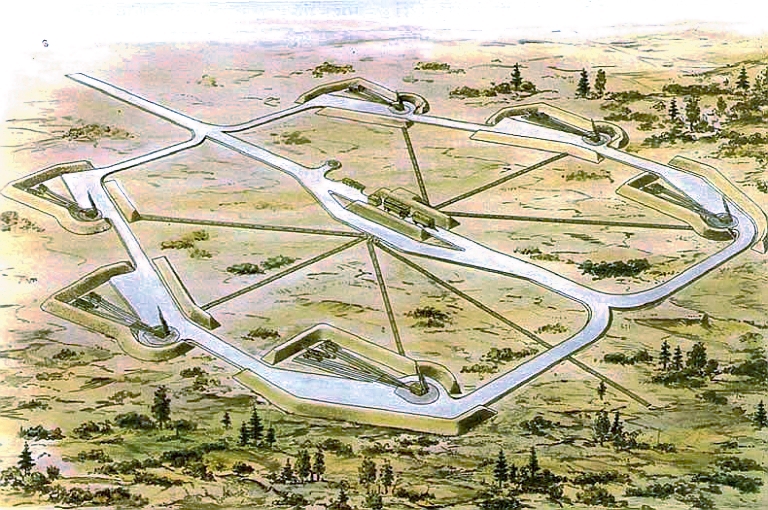 S-200 battery deployment
illustration from Soviet technical manual. Note each launcher has a
pair of transloaders with ready 5V28 rounds (RuMoD).
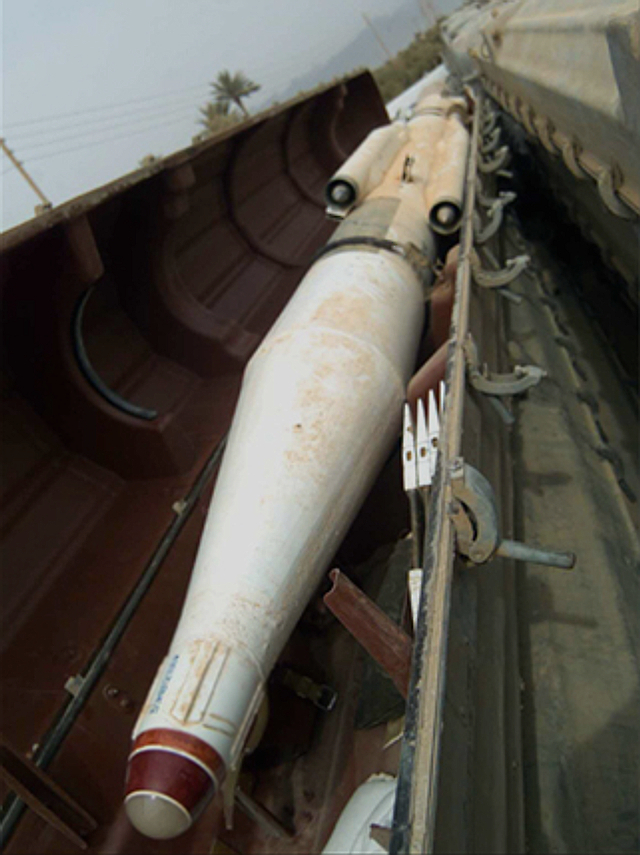 Captured Iraqi 3M9/R-60 hybrid heatseeking
Gainful round in 2003. Note the Magnesium Fluoride nose window and ad
hoc
removal of the fixed nose strakes (US DoD image).
 Cuban SA-3 TELs on display (via Vestnik-PVO). 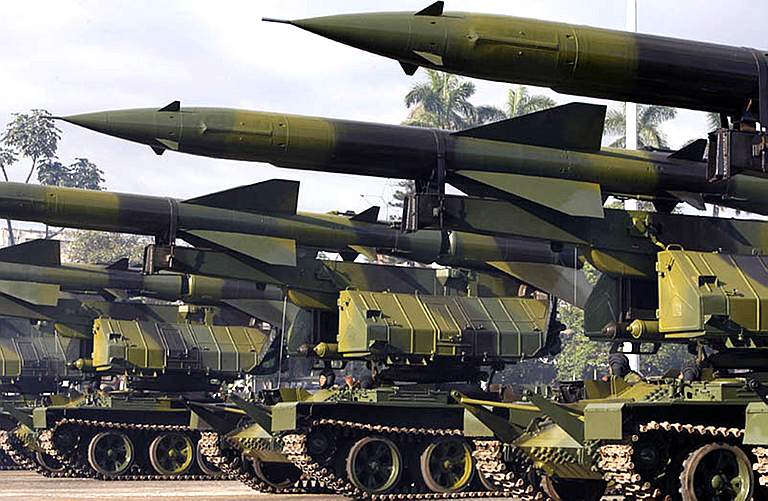 Cuban SA-2 TELs on parade in Havana, 2006 (via Vestnik-PVO).  Above:
Operational
deployment
of
a
Vostok
E at a prepared site. Below: the Vostok E can stow and deploy in as
little as 6 minutes, making it a genuine shoot-and-scoot battery
component. The Belarus KB Radar developed Vostok E is a highly mobile,
solid state digital VHF-Band 2D acquisition radar developed as a direct
replacement for the P-18 Spoon Rest in SA-2, SA-3, SA-6, SA-8 and other
SAM batteries. KBR claim the use of noise-like LPI waveforms in this
DMTI design. A hybrid legacy SAM battery incorporating the Vostok E
will be much more difficult to acquire, track, jam and engage.
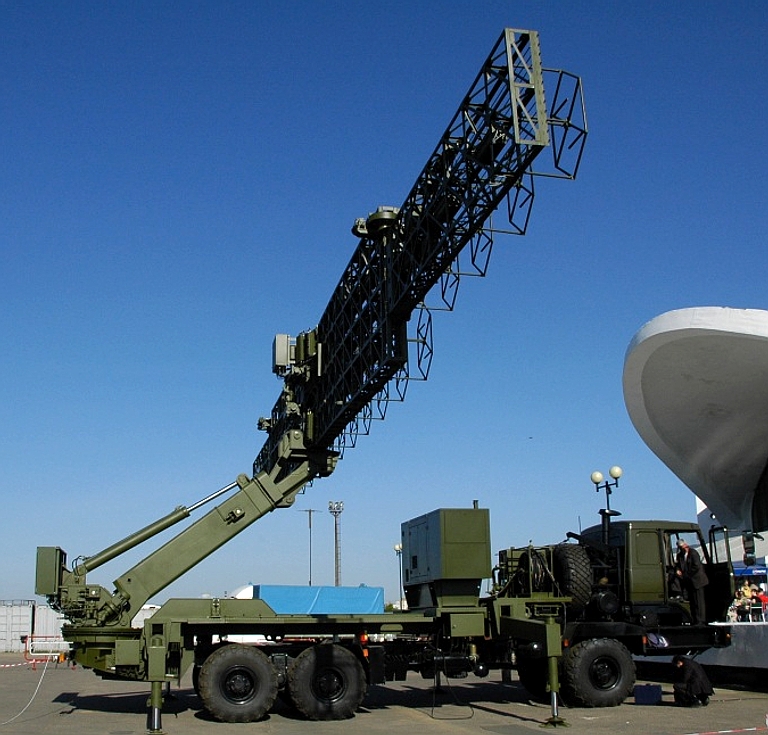 |
||||||||||||||||||||||||||||
| The best known historical
example of hybridisation occurred when the Soviets transitioned from
the 2K12 Kub/Kvadrat / SA-6 Gainful to the 9K37 / Buk / SA-11
Gadfly. The 9S35 Fire Dome engagement radar appeared on late model SA-6
TELARs, and SA-11 weapon systems were capable of controlling late model
SA-6 TELARs and vice versa. The best known recent example of hybridisation has been the introduction of interfaces and software on the S-300PMU2 Favorit / SA-20 Gargoyle and S-400 Triumf / SA-21 to control the S-200 Angara/Vega/Dubna / SA-5 Gammon and its 5N62 Square Pair engagement radar. In this arrangement, an SA-20/21 system with its high power aperture and highly jam resistant acquisition and engagement radars prosecutes an engagement, but rather than launching its organic 48N6 series missile rounds, it uses the SA-5 Gammon round instead. The 5N62 Square Pair is effectively slaved to the 30N6E2 or 92N6E phased array engagement radar and acts as a specialised Continuous Wave illuminator, rather than long range target tracking and illuminating element of the battery. This model is analogous to the S-300V/SA-12 scheme, where the 9A82/83 TELARs with their CW illuminators are slaved to the 9S32 Grill Pan phased array engagement radar. The notion that any part of the cumbersome, slow and electronically vulnerable acquisition and tracking function of the Squair Pair would be retained in the hybrid system makes no sense, and indeed it would nullify many of the benefits of using the hybrid in the first place. This has important implications for future combat against users of this hybrid system. In the legacy SA-5 system, a search radar such as a Tall King or Bar Lock would cue the Square Pair engagement radar, which would search the area of interest with a narrow pencil beam in an automated spiral or raster pattern, or manually, until the target was acquired and tracked, upon which the SA-5 missiles with CW homing seekers were tuned to the CW carrier (in early variants) and then launched. As the 1980s skirmishes between the US Navy and Libyan air defences illustrated, US EA-6B Prowlers with their ALQ-99 jamming equipment were able to successfully disrupt tracking by the Square Pair and render the SA-5 missiles unusable. In a hybrid SA-5/SA-20/SA-21 system, attempts to jam the Squair Pair will be ineffective as it is functioning as a simple open loop CW illuminator and missile command uplink transmitter. Because the SA-5 is a static system, operators can precisely calibrate the Square Pair in azimuth and elevation, and given the availability of Glonass, GPS and satellite imagery, this calibration is neither expensive in time or resources. Once this has been performed it presents no difficulties for a Glonass/GPS equipped autonomous SA-20/21 battery to issue over a radio datalink launch and cueing commands to the SA-5 battery, and once the missiles have been launched, precision elevation and azimuth commands to the Square Pair to control illumination and missile uplink functions. Indeed, once such integration has been performed, it is an open question whether it would be even economical let alone operationally viable to retain the full SA-5 battery package of K-1, K-2, K-3 and K-9 trailers, as a rack of digital equipment installed in the Square Pair K-1/1M radar head trailer to provide interface and control functions would be cheaper to run and more effective in combat. The challenge which a hybrid SA-5/SA-20/SA-21 system presents is considerable. The SA-20/21 battery is highly mobile, and with modern digital frequency hopping radars, will be difficult to jam. Soft kill and hard kill become problematic. In terms of defeating the SA-5 component of the hybrid, the only option is to jam the missile CW homing seeker, the effectiveness of which will depend entirely on the vintage of the 5G24N series seeker and the capabilities of the jamming equipment. If the customer opts for an upgrade to the seeker electronics, the seeker may be digital and very difficult to jam. The hybrid SA-5/SA-20 option is available to nations using both of the SAM systems - known instances being Syria and the Ukraine. Iran was a candidate until Russia cancelled the export of SA-20A systems as a result of the UN embargo. The hybridisation of the SA-5 presents a good case study of what is achievable for modest development investment. It also allows Russia to provide a counter-ISR capability to nations whom they may not trust with the most advanced weapons such as the SA-21 40N6 missile, currently in test. Some evidence has emerged, albeit inconclusive as it is not supported by public disclosures, that the PLA may be hybridising its new HQ-12/KS-1A SAM system with the legacy HQ-2B/J / CSA-2 Guideline SAM system. The PLA remains the world's largest single user of the SA-2, with domestically re-engineered missile rounds and SJ-202 Gin Sling series engagement radars. The PLA has also deployed a fully mobile HQ-2 TEL on a tracked chassis. In practical terms the PLA has a large material and intellectual investment in the SA-2 family of weapons. Hybridising the HQ-2 and HQ-12 would therefore make sense economically as it would allow exploitation of the HQ-2 inventory and warstock until the type is wholly replaced by newer technology weapons. As the HQ-2 is a simple command link guided missile, hybridisation with a newer missile system involves only the installation of software and hardware in the engagement radar which cues and commands the HQ-2B TELs or static SM-90 launchers, permits tracking of the missile, and which generates uplink commands to the missile during flight. With the Fan Song / Gin Sling operating at X-band (G/E/F depending on subtype), and given the robust antenna bandwidth available with a transmissive space feed PESA arrangement as used in the H-200 engagement radar for the HQ-12/KS-1A, there would be no fundamental technological obstacles to adapting the H-200 to provide a midcourse tracking and command uplink guidance capability for the HQ-2 / SA-2 missile round. It is worth observing that Chinese sources claim the predecessor to the KS-1A, the KS-1, employed the same Gin Sling engagement radar as the HQ-2B/J. If this is true, then the degree of commonality in missile electronics and waveforms between the KS-1A and HQ-2B/J could be very high indeed, facilitating hybridisation. A HQ-2B/J missile battery equipped with a modern frequency hopping H-200 engagement radar and a JY-11/JY-11B, YLC-18, JYL-1 acquisition radar becomes an entirely different proposition to the legacy article, in terms of its engagement envelope, tactical mobility, and its resistance to jamming. Given the large number of existing users of the S-75 / SA-2 and HQ-2 / CSA-1 on the global stage, China could well have a major commercial motive to develop a hybrid domestically, since it would open a significant export market for the H-200 radar, and its competitor, the SJ-231, as well as replacement JY-11B, YLC-18 and JYL-1 acquisition radars. In conclusion, hybridisation is a trend which is likely to grow over time as users of legacy Soviet era SAM systems seek to exploit their sunk investments and the vastly better capabilities of new technology phased array engagement radars, and manufacturers of radar equipment seek to expand their markets. |
||||||||||||||||||||||||||||
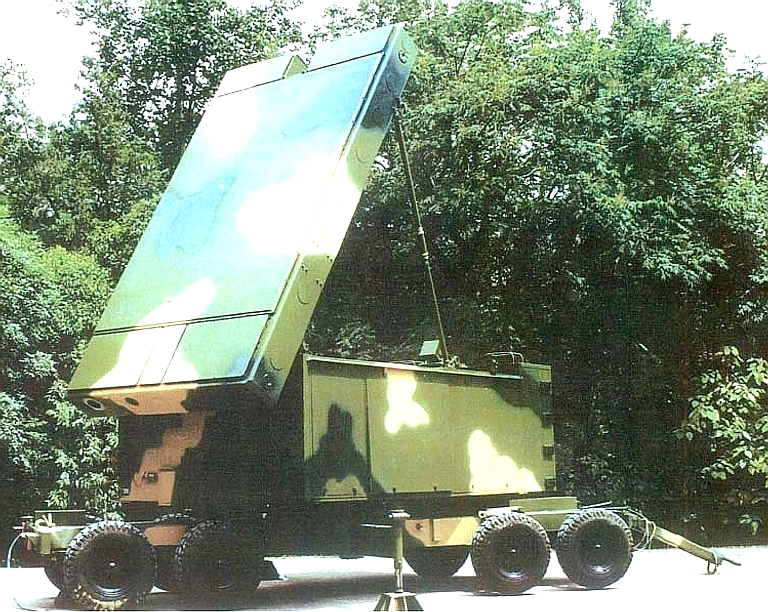 The H-200 phased array engagement radar
was developed to support the new HQ-12/KS-1A SAM system. Hybridisation
of the H-200 radar and the existing HQ-2B/J missile system would
transform the capabilities of the HQ-2, and open up a large export
market for the H-200 and other Chinese radars (Chinese internet images).
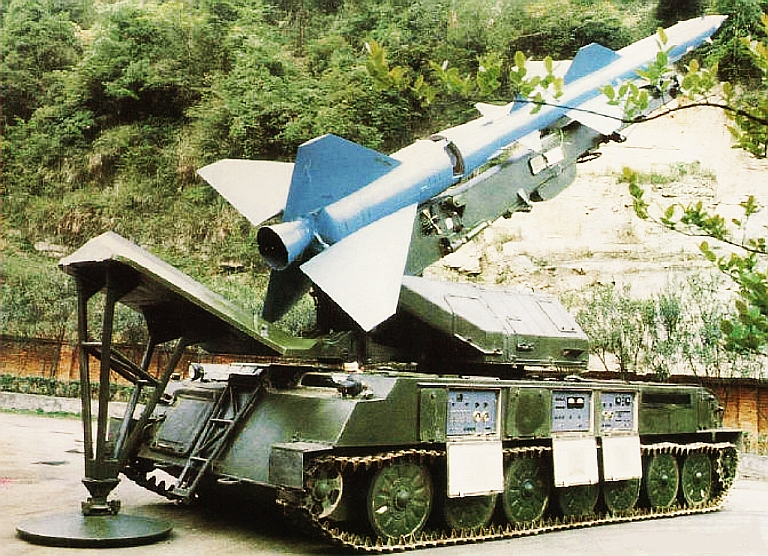 Further Reading: SAM
System Index - [Click for more...]
Legacy SAM System Upgrades - [Click for more ...] SAM System Mobility - Air Defence System Vehicles [Click for more ...] SAM System Integration - Air Defence Command Posts [Click for more ...] SAM System Passive Targeting - Emitter Locating Systems [Click for more ...] SAM System Counter VLO Capabilities [Click for more ...] SAM System Proliferation - PLA Air Defence Missile Systems [Click for more ...] SAM System Multimedia - Rosoboronexport Footage [Click for more ...] |
||||||||||||||||||||||||||||
| References:
J.C. Wise, Said Aminov / Vestnik PVO,
http://www.s-200.de/ |
||||||||||||||||||||||||||||
| Air
Power Australia Website - http://www.ausairpower.net/ Air Power Australia Research and Analysis - http://www.ausairpower.net/research.html |
||||||||||||||||||||||||||||
 |
||||||||||||||||||||||||||||
| |
||||||||||||||||||||||||||||
|
|||||||||||||
![Sukhoi PAK-FA and Flanker Index Page [Click for more ...]](APA/flanker.png) |
![F-35 Joint Strike Fighter Index Page [Click for more ...]](APA/jsf.png) |
![Weapons Technology Index Page [Click for more ...]](APA/weps.png) |
![News and Media Related Material Index Page [Click for more ...]](APA/media.png) |
||||||||||
![Surface to Air Missile Systems / Integrated Air Defence Systems Index Page [Click for more ...]](APA/sams-iads.png) |
![Ballistic Missiles and Missile Defence Page [Click for more ...]](APA/msls-bmd.png) |
![Air Power and National Military Strategy Index Page [Click for more ...]](APA/strategy.png) |
![Military Aviation Historical Topics Index Page [Click for more ...]](APA/history.png)
|
![Information Warfare / Operations and Electronic Warfare Index Page [Click for more ...]](APA/iw.png) |
![Systems and Basic Technology Index Page [Click for more ...]](APA/technology.png) |
![Related Links Index Page [Click for more ...]](APA/links.png) |
|||||||
![Homepage of Australia's First Online Journal Covering Air Power Issues (ISSN 1832-2433) [Click for more ...]](APA/apa-analyses.png) |
|||||||||||||
| Artwork, graphic design, layout and text © 2004 - 2014 Carlo Kopp; Text © 2004 - 2014 Peter Goon; All rights reserved. Recommended browsers. Contact webmaster. Site navigation hints. Current hot topics. | |||||||||||||
|
Site Update
Status:
$Revision: 1.753 $
Site History: Notices
and
Updates / NLA Pandora Archive
|
|||||||||||||
|
|
Tweet | Follow @APA_Updates | |||||||||||
|
|
|||||||||||||
|
|
|||||||||||||